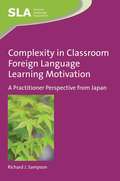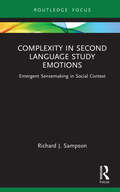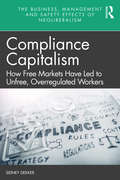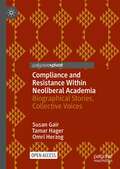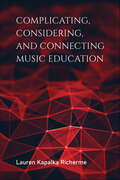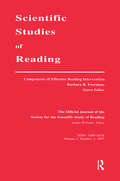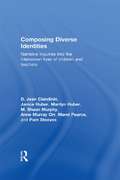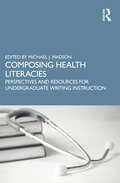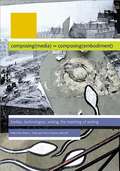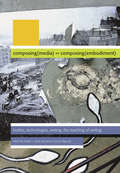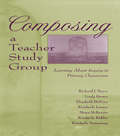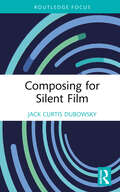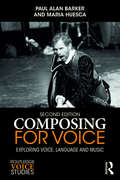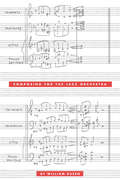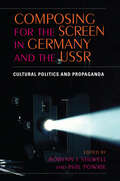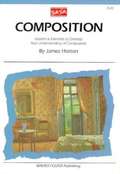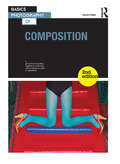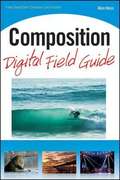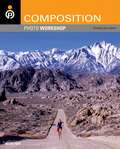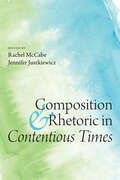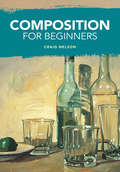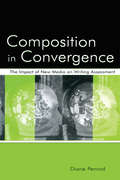- Table View
- List View
Complexity in Classroom Foreign Language Learning Motivation: A Practitioner Perspective from Japan
by Richard J. SampsonThis book explores how complex systems theory can contribute to the understanding of classroom language learner motivation through an extended examination of one particular, situated research project. Working from the lived experience of the participants, the study describes how action research methods were used to explore the dynamic conditions operating in a foreign language classroom in Japan. The book draws attention to the highly personalised and individual, yet equally co-formed nature of classroom foreign language learning motivation and to the importance of agency and emotions in language learning. It presents an extended illustration of the applicability of complex systems theory for research design and process in SLA and its narrative approach shines light upon the evolving nature of research and role of the researcher. The study will be a valuable resource for practitioners, researchers and postgraduate students interested in classroom language teaching and learning, especially those with a focus on motivation among learners.
Complexity in Games Teaching and Coaching: A Multi-Disciplinary Perspective (Routledge Research in Sports Coaching)
by Felix LebedShedding new light on sport pedagogy and the teaching and coaching of games, this book shows how complexity theory can be used to improve team sport performance, coach education, and young player development. The book draws together insights from both the humanities and behavioural sciences, including psychology, philosophy, anthropology, sociology, history, and play theory into a new educational methodology for team sports. It shows how concepts from complexity theory underpin and inform team sport dynamics, including the uncontrolled nature of live human systems; the nature of complex systems and how this shapes student and young athlete learning; self-organization and its relation to decision-making in play; and mental self-regulation and motivation. It presents an innovative and sophisticated definition of sport pedagogy that can help teachers and coaches deepen their understanding of teaching and learning in team sports and help them develop more motivated, more effective, and more creative athletes.
Complexity in Second Language Study Emotions: Emergent Sensemaking in Social Context (Routledge Research in Language Education)
by Richard J. SampsonThis book offers a socially situated view of the emergence of emotionality for additional language (L2) learners in classroom interaction in Japan. Grounded in a complexity perspective, the author argues that emotions need to be studied as they are dynamically experienced and understood in all of their multidimensional colors by individuals (in interaction). Via practitioner research, Sampson applies a small-lens focus, interweaving experiential and discursive data, offering possibilities for exploring, interpreting and representing the lived experience of L2 study emotions in a more holistic yet detailed, social yet individual fashion. Amidst the currently expanding interest in L2 study emotions, the book presents a strong case for the benefits of locating interpretations of the emergence of L2 study emotions back into situated, dynamic, social context. Sampson’s work will be of interest to students and researchers in second language acquisition and L2 learning psychology.
Compliance Capitalism: How Free Markets Have Led to Unfree, Overregulated Workers (The Business, Management and Safety Effects of Neoliberalism)
by Sidney DekkerIn this book, Sidney Dekker sets out to identify the market mechanisms that explain how less government paradoxically leads to greater compliance burdens. This book gives shape and substance to a suspicion that has become widespread among workers in almost every industry: we have to follow more rules than ever—and still, things can go spectacularly wrong. Much has been privatized and deregulated, giving us what is sometimes known as ‘new public management,’ driven by neoliberal, market-favoring policies. But, paradoxically, we typically have more rules today, not fewer. It’s not the government: it’s us. This book is the first of a three-part series on the effects of ‘neoliberalism,’ which promotes the role of the private sector in the economy. Compliance Capitalism examines what aspects of the compliance economy, what mechanisms of bureaucratization, are directly linked to us having given free markets a greater reign over our political economy. The book steps through them, picking up the evidence and levers for change along the way. Dekker’s work has always challenged readers to embrace more humane, empowering ways to think about work and its quality and safety. In Compliance Capitalism, Dekker extends his reach once again, writing for all managers, board members, organization leaders, consultants, practitioners, researchers, lecturers, students, and investigators curious to understand the genuine nature of organizational and safety performance.
Compliance and Resistance Within Neoliberal Academia: Biographical Stories, Collective Voices
by Susan Gair Tamar Hager Omri HerzogThis book reflects on academic life under a neoliberal regime. Through collaborative autoethnographies, the authors share stories about the everyday experiences, dilemmas and conflicts of three academics: the struggle for promotion, teaching’s challenges, the race to publish, confronting bureaucracy and institutional politics, as well as the resulting emotional stress. These stories reveal the impact of neoliberal culture on ideological, economic, social, collegial, and emotional integrity which are integral to academics’ lives today. But along with the challenges, the authors present their vision of hope, and transformation through academic solidarity - and for the silenced voices to be heard, inside academia and beyond it.
Complicating, Considering, and Connecting Music Education (Counterpoints: Music and Education)
by Lauren Kapalka RichermeIn Complicating, Considering, and Connecting Music Education, Lauren Kapalka Richerme proposes a poststructuralist-inspired philosophy of music education. Complicating current conceptions of self, other, and place, Richerme emphasizes the embodied, emotional, and social aspects of humanity. She also examines intersections between local and global music making. Next, Richerme explores the ethical implications of considering multiple viewpoints and imagining who music makers might become. Ultimately, she offers that music education is good for facilitating differing connections with one's self and multiple environments. Throughout the text, she also integrates the writings of Gilles Deleuze and Félix Guattari with narrative philosophy and personal narratives. By highlighting the processes of complicating, considering, and connecting, Richerme challenges the standardization and career-centric rationales that ground contemporary music education policy and practice to better welcome diversity.
Components of Effective Reading Intervention: A Special Issue of scientific Studies of Reading
by Barbara R. FoormanLearning to read is not natural for many individuals, who remain dependent on the skill, knowledge, and persistence of their teachers to acquire reading proficiency. Reading instruction, however, can be designed with greater validity than ever before because of a solid, converging body of scientific research on reading acquisition, reading processes, and reading disabilities. This special issue presents some of the major advances in methodologically and theoretically sound treatment research by the use of comprehensive and multivariate treatment protocols and individual growth-curve modeling.
Composing Diverse Identities: Narrative Inquiries into the Interwoven Lives of Children and Teachers (Teachers, Teaching and Learning)
by D. Jean Clandinin Janice Huber M. Shaun Murphy Pam Steeves Marilyn Huber Anne Murray Orr Marni PearceIn a climate of increasing emphasis on testing, measurable outcomes, competition and efficiency, the real lives of children and their teachers are often neglected or are too messy and intricate to legislate and quantify. As such, curricula are designed without including the very people that compose the identities of schools. Here Clandinin takes issue with this tendency, bringing together a collection of narratives from seven writers who spent a year in an urban school, exploring the experiences and contributions of children, families, teachers and administrators. These stories show us an alternative way of attending to what counts in schools, shifting away from the school as a business model towards an idea of schools as places to engage citizenship and to attend to the wholeness of people’s lives. Articulating the complex ethical dilemmas and issues that face people and schools every day, this fascinating study puts school life under the microscope raises new questions about who and what education is for.
Composing Health Literacies: Perspectives and Resources for Undergraduate Writing Instruction
by Michael J. MadsonThis edited collection examines engagements between health literacies and undergraduate writing instruction, providing research, case studies, and practical guidance on developing an interdisciplinary writing pedagogy. Bringing together works from scholars in rhetoric and composition, technical communication, UX, public health, nursing, and writing center administration, this collection showcases a range of evidence-based practices for composing, teaching, and assessing health literacies, which the readers can apply to their own contexts. Using non-specialist language accessible to instructors from a variety of backgrounds, the chapters consider the use of writing assignments including image analyses, public service announcements, podcasts, health education materials, illness narratives, public presentations, research proposals, and journal articles. The book offers a holistic overview by profiling entire writing programs, both online and face-to-face, that teach health literacies across their curricula. This evidence-based collection is essential reading for scholars and instructors in rhetoric and composition, writing in the health professions, technical communication, and health humanities, and can be used as a supplemental textbook for pedagogy courses in these fields.
Composing Media Composing Embodiment
by Anne Wysocki Kristin L Arola"What any body is--and is able to do--cannot be disentangled from the media we use to consume and produce texts." ---from the Introduction.Kristin Arola and Anne Wysocki argue that composing in new media is composing the body--is embodiment. In Composing (Media) = Composing (Embodiment), they have brought together a powerful set of essays that agree on the need for compositionists--and their students--to engage with a wide range of new media texts. These chapters explore how texts of all varieties mediate and thereby contribute to the human experiences of communication, of self, the body, and composing. Sample assignments and activities exemplify how this exploration might proceed in the writing classroom.Contributors here articulate ways to understand how writing enables the experience of our bodies as selves, and at the same time to see the work of (our) writing in mediating selves to make them accessible to institutional perceptions and constraints. These writers argue that what a body does, and can do, cannot be disentangled from the media we use, nor from the times and cultures and technologies with which we engage. To the discipline of composition, this is an important discussion because it clarifies the impact/s of literacy on citizens, freedoms, and societies. To the classroom, it is important because it helps compositionists to support their students as they enact, learn, and reflect upon their own embodied and embodying writing.
Composing Media Composing Embodiment
by Kristin L. Arola and Anne Frances Wysocki“What any body is—and is able to do—cannot be disentangled from the media we use to consume and produce texts.” ---from the Introduction. Kristin Arola and Anne Wysocki argue that composing in new media is composing the body—is embodiment. In Composing (Media) = Composing (Embodiment), they havebrought together a powerful set of essays that agree on the need for compositionists—and their students—to engage with a wide range of new media texts. These chapters explore how texts of all varieties mediate and thereby contribute to the human experiences of communication, of self, the body, and composing. Sample assignments and activities exemplify how this exploration might proceed in the writing classroom. Contributors here articulate ways to understand how writing enables the experience of our bodies as selves, and at the same time to see the work of (our) writing in mediating selves to make them accessible to institutional perceptions and constraints. These writers argue that what a body does, and can do, cannot be disentangled from the media we use, nor from the times and cultures and technologies with which we engage. To the discipline of composition, this is an important discussion because it clarifies the impact/s of literacy on citizens, freedoms, and societies. To the classroom, it is important because it helps compositionists to support their students as they enact, learn, and reflect upon their own embodied and embodying writing.
Composing a Civic Life, A Rhetoric and Readings for Inquiry and Action, Second Edition
by Michael Berndt Amy MuseComposing a Civic Life, A Rhetoric and Readings for Inquiry and Action, Second Edition, is a 600 page Freshman reader compiled and written by the Minnesota academics Michael Berndt and Amy Muse. It contains progressively arranged essays on citizenship, community life, race and gender relations, family and marriage issues, world connections, and environmental concerns. These are embedded in an elaborate teaching apparatus detailing points of composition, writing projects, and classroom activities. The authors describe their goals in these words: We wrote the first edition of Composing a Civic Life between 1999 and 2002; during that period we witnessed a broad calling for civic engagement. Social, religious, and political leaders were urging Americans to become more engaged in their communities. Scholars and activist writers such as Robert Putnam, Jedediah Purdy, and Paul Rogat Loeb were calling citizens to strengthen community ties. Politicians and community leaders including Al Gore, Sam Nunn, Ervin Duggan, and Colin Powell were calling citizens to renew America's social contract by volunteering or participating in community affairs. Since that time, we have seen many examples of increased civic engagement, from the expansion of organizations such as Moveon.org and True Majority to the renewed civic mission of high schools and universities.
Composing a Teacher Study Group: Learning About Inquiry in Primary Classrooms
by Richard J. Meyer With Linda Brown Elizabeth DeNino Kimberly Larson Mona McKenzieThere has been a flurry of writing about teachers as inquirers and researchers as well as books about children as inquirers. This volume brings these two areas together -- teachers and students are inquiring at Ridgeway Elementary School. It demonstrates the importance of thought collectives as forums for student and teacher learning. The children in the primary classrooms in this book are working to understand the world around them and their place in it as literate individuals. Their teachers are studying themselves and the students. No other book describes the way this work affects children, teachers, and the ethos of the school in which the work occurs. In that sense, this book is groundbreaking in that it is an honest portrayal of the joys and sorrows, the successes and the stumbling blocks, the clear vision, and the obfuscating that teachers live as they enact a life of asking questions, being curious, wandering, and wondering. Acknowledging and honoring the many faces of inquiry in schools, this book demonstrates the children's inquiry, their teachers' inquiry, and the place of that inquiry in schools. It lays out the ways in which inquiry is fundamental to teaching and learning in a democracy in which all of the members of the community have a voice in deciding curricular directions and ways of presenting learning. Teachers are presented as thinkers and learners, not merely as technicians enacting others' views of what is to be learned and when. Readers will find teachers dealing with the real issues of life in schools; they will see how teachers can use their existing situations as points of departure for their growth and their students' learning.
Composing for Silent Film
by Jack Curtis DubowskyComposing for Silent Film offers insight, information, and techniques for contemporary composition, arrangement, and live score performance for period silent film. A specialized music composition guide, this book complements existing film scoring and contemporary music composition texts. This book helps today’s composers better understand and correctly interpret period silent film, and to create and perform live scores that align with films’ original intentions, so that audiences notice and grasp fine points of the original film. Composing for Silent Film analyzes period silent film and its conventions – from Delsarte acting gestures to period fascinations and subtexts. As a practical composition text, it weighs varying approaches, including improvisation, through-scoring, "mickey-mousing," handling dialogue, and dividing roles amongst players. It steers composers towards informed understanding of silent film, and encourages them to deploy contemporary styles and techniques in exciting ways.For clarity and concision, examples are limited to nine canonical silents: Metropolis, Dr. Jekyll and Mr. Hyde, The Mark of Zorro, Sunrise: A Song of Two Humans, The Black Pirate, Nosferatu, The Phantom Carriage, Daisy Doodad’s Dial, and The Golem.
Composing for Voice: Exploring Voice, Language and Music (Routledge Voice Studies)
by Paul Barker Maria HuescaComposing for Voice: Exploring Voice, Language and Music, Second Edition, elucidates how language and music function together from the perspectives of composers, singers and actors, providing an understanding of the complex functions of the voice pedagogically, musicologically and dramatically. Composing for Voice examines the voice across a wide range of musical genres (including pop, jazz, folk, classical, opera and the musical) and explores the fusion of language and music that is unique to song. This second edition is enlarged to attract a wider readership amongst all music and theatre professionals and educators, whilst also engaging an international audience with the introduction of new co-author Maria Huesca. New to the second edition: A review of the history of singing An overview of the development of melisma A chapter to help performers understand each other, as singers and actors often receive disparate educations Case studies and qualitative research around song, lyric and meaning A discussion of the synthetic voice An introduction to the concept of embodied composition Interviews with composers and singers Summaries of various vocal styles A website with links to performances discussed, as well as related workshops: www.composingforvoice.com Composing for Voice: Exploring Voice, Language and Music, Second Edition, articulates possibilities for the practical exploration of language, music and voice by composers, singers and actors.
Composing for the Jazz Orchestra
by William Russo"Although it will be of primary interest to those who are engaged in composition themselves, [this] book is also recommended for readers who may wish to gain further insight into just what makes jazz composition so different from traditional approaches."—Malcolm Bessom, The Music Magazine
Composing for the Screen in Germany and the USSR: Cultural Politics and Propaganda
by Phil Powrie Robynn J. StilwellDespite the long history of music in film, its serious academic study is still a relatively recent development and therefore comprises a limited body of work. The contributors to this book, drawn from both film studies and musicology, attempt to rectify this oversight by investigating film music from the vibrant, productive, politically charged period before World War II. They apply a variety of methodologies--including archival work, close readings, political histories, and style comparison--to this under explored field.
Composition
by James HortonAll good paintings are composed, whether consciously or unconsciously. If you are working direct from a landscape subject, you can only compose with what you see before you, but for studio paintings you have more leeway because you can arrange the subject as you choose. In the first part of this book the author has dealt with what might be termed "rearranging nature," while in the second he has provided some ideas on composing portraits, still life and floral groups by planning the initial set-up as well as the painting itself. He has also explained some of the more formal rules of composition based on geometry -- most artists are aware of these, and you may find them interesting even if you do not see an immediate application to your own work.
Composition (Basics Photography)
by David PrakelStrong images only come about through a combination of technical excellence and thorough composition. While there is plenty of technical advice, photographers often turn to fine-art sources for the so-called 'rules of composition'. This book, however, acknowledges photography's quite different dynamic and offers a contemporary approach to composition more suited to the medium. The second edition of Basics Photography 01: Composition offers a contemporary approach to composition. Its six core chapters cover historical background and personal motivation, formal elements, space and time within the photographic frame and composition in real-world situations. The Basics Photography series, originally published by AVA Publishing, comprises a collection of titles including: Lighting, Composition, Capturing Colour, Post-Production Black & White, Post-Production Colour, Working in Black & White and Exposure. Easily accessible and highly readable, the books clearly explain and explore fundamental photographic concepts; they are fully indexed and illustrated with clear diagrams and inspiring imagery, building to provide an essential introduction to the subject.
Composition Digital Field Guide
by Alan HessThe go-with-you guide for creating strong compositions every time you take a photo Composition requires purposeful placement of elements within the frame, including backgrounds, foregrounds, main subjects, and much more. It can take years to acquire strong compositional skills. That's where Composition Digital Field Guide comes in. Packed with full-color photos, this handy guide teaches you how to bring together photographic elements to produce photos that are unique, creative, and memorable. Addresses the skills required to master the art of good composition when taking digital photos Walks you through framing your images carefully, which is the first key step in capturing a strong photograph Features hundreds of stunning and inspiring full-color photos of people, wildlife, and landscapes Includes the newest feature of the Digital Field Guide series: a removable color checker card to help ensure true color in your photographs It will be difficult to keep your composition while reading the invaluable advice in Composition Digital Field Guide!
Composition Photo Workshop
by Blue FierThe hands-on instruction that digital photographers need to compose great shots Introducing readers to the basic elements of design, this full-color guide shows photographers step by step how to frame great compositions before they take the shot. Instructions, advice, examples, and assignments cover all types of photography.
Composition and Cognition: Reflections on Contemporary Music and the Musical Mind
by Fred LerdahlIn Composition and Cognition, renowned composer and theorist Fred Lerdahl builds on his careerlong work of developing a comprehensive model of music cognition. Bringing together his dual expertise in composition and music theory, he reveals the way in which his research has served as a foundation for his compositional style and how his intuitions as a composer have guided his cognitively oriented theories. At times personal and reflective, this book offers an overall picture of the musical mind that has implications for central issues in contemporary composition, including the recurrent gap between method and result, and the tension between cognitive constraints and utopian aesthetic views of musical progress. Lerdahl’s succinct volume provides invaluable insights for students and instructors, composers and music scholars, and anyone engaged with contemporary music.
Composition and Rhetoric in Contentious Times
by Rachel McCabe Jennifer JuszkiewiczComposition and Rhetoric in Contentious Times poses critical questions of representation, accessibility, social justice, affect, and labor to better understand the entwined future of composition and rhetoric. This collection of essays offers innovative approaches for socially attuned learning and best practices to support administrators and instructors. In doing so, these essays guide educators in empowering students to write effectively and prepare for their role as global citizens. Editors Rachel McCabe and Jennifer Juszkiewicz consider how educators can respond to multiple current crises relating to composition and rhetoric with generosity and cautious optimism; in the process, they address the current concerns about the longevity of the humanities. By engaging with social constructivist, critical race, socioeconomic, and activist pedagogies, each chapter provides an answer to the question, How can our courses help students become stronger writers while contending with current social, environmental, and ethical questions posed by the world around them? The contributors consider this question from numerous perspectives, recognizing the important ways that power and privilege affect our varying means of addressing this question. Relying on both theory and practice, Composition and Rhetoric in Contentious Times engages the future of composition and rhetoric as a discipline shaped by recent and current global events. This text appeals to early-career writing program administrators, writing center directors, and professional specialists, as well as Advanced Placement high school instructors, graduate students, and faculty teaching graduate-level pedagogy courses.
Composition for Beginners
by Craig NelsonArtist Craig Nelson covers all the basics of composition. From perspective to proportion, you will discover the keys to unlocking the secrets needed to improve your skills and create outstanding works of art.
Composition in Convergence: The Impact of New Media on Writing Assessment
by Diane PenrodComposition in Convergence: The Impact of New Media on Writing Assessment considers how technological forms--such as computers and online courses--transform the assessment of writing, in addition to text classroom activity. Much has been written on how technology has affected writing, but assessment has had little attention. In this book, author Diane Penrod examines how, on the one hand, computer technology and interactive material create a disruption of conventional literacy practices (reading, writing, interpreting, and critique), while, on the other hand, the influence of computers allows teachers to propose and develop new models for thinking and writing to engage students in real-world settings.This text is intended for scholars and educators in writing and composition, educational assessment, writing and technology, computers and composition, and electronic literacy. In addition, it is appropriate for graduate students planning to teach and assess electronic writing or teach in online environments.
